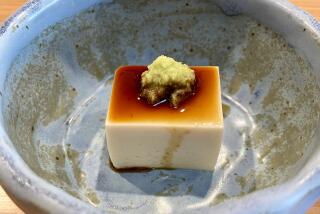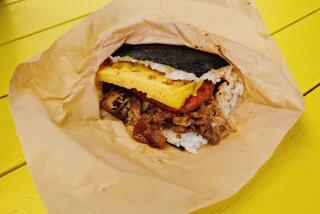Could that be ice in my soup?
Summer in Koreatown has long been marked by the sounds of slurping. The season for naeng myun -- cold noodles -- is now in full swing, and at restaurants across the neighborhood, huge bowlfuls of chewy buckwheat noodles quickly disappear. Occasionally there are pauses for a spoonful of icy-cold tangy broth, a bite of crunchy pickled daikon or cucumber, a sliver of crisp-sweet Asian pear, or a slice of tender beef brisket.
Naeng myun is a light, refreshing dish from North Korea especially popular during the humid summers of the Korean peninsula’s monsoon season. At the restaurant chain Yu Chun in Los Angeles, the broth is icy cold -- with snowy, shaved ice piled on top. It’s not unheard of at restaurants here to find ice cubes floating in one’s broth, although the practice of adding ice isn’t de rigueur in the Koreas.
The soup is traditionally made with a combination of beef broth and dongchimi brine (the clear liquid used for pickling a particular type of daikon kimchi), and its cold temperature doesn’t stun or overwhelm so much as heighten the interplay between sweet noodles and sour soup.
In mul naeng myun (cold noodles in soup), the most popular preparation of naeng myun, noodles are piled high in the cool, beefy-tangy broth. Other traditional styles include hoe naeng myun (cold noodles with raw fish), in which the noodles are topped with slices of raw fish and mixed with a chile-pepper dressing, and yeolmu naeng myun (cold noodles with young radish), served with fermented baby radish in the soup.
Mul naeng myun always comes with that neat stack of thinly sliced beef, typically brisket or shank, lightly pickled cucumber and daikon, sliced pear and half a hard-boiled egg -- a small mountain of chewy and crunchy textures.
The slurping may not commence, however, without a dollop of Asian hot mustard, a splash of vinegar and a sprinkling of sugar administered table side.
Tangy mul naeng myun is so popular a refresher that it also doubles as a palate cleanser after a main course of kalbi, Korean barbecue beef short ribs. Large bowls of it are dropped off at the table like entree-size desserts, complete with new sets of chopsticks and soup spoons. The sweet noodles and cold broth feel just right after the parade of sticky, sauced beef.
Making the dish from scratch requires only enough time to make a quick beef stock and enough patience to allow the soup to cool to an icy temperature.
Most important, according to several Korean restaurants with a signature naeng myun, is striking the right balance between homemade beef broth and the dongchimi (watery radish kimchi) brine, sold in large tubs at most Korean grocers. The brine typically is made with water, garlic, ginger, green onions, chiles and pear.
Selecting the right noodle is also key. Korean buckwheat noodles, available here in packages with generic English labeling such as “Oriental style noodles,” are the common and most popular noodles used in cold preparations. They’re made with a mix of buckwheat and sweet-potato flours and have a slightly sweeter and chewier texture than soba, the Japanese counterpart made of buckwheat and wheat flours.
One popular alternative is arrowroot noodles, which are slightly gelatinous and more elastic. Restaurant servers often cut the noodles with scissors right at the table to make them easier to eat.
At Korean markets, there are long rows of noodles of all kinds: rice noodles, buckwheat noodles, unrefined buckwheat noodles, etc. But ingredients are listed in English on the back of the package; look for buckwheat flour and sweet-potato starch (or for arrowroot, if you choose).
In addition to traditional mul naeng myun, another great version of Korean cold noodles to make at home is a seafood variation with a shrimp- and fish-based broth. Like hoe naeng myun, it has skate wing -- but cooked, just until slightly firm but tender. And the broth takes even less time to make than the traditional beef naeng myun.
The only other requisite is a set of really big bowls. Punch bowls would not be out of order.
Cold noodles in beef broth (Mul naeng myun)
Total time: About 1 hour, 30 minutes plus chilling time
Servings: 4
Note: Adapted from “Korean Cooking for Everyone” by Ji Sook Choe and Yukiko Moriyama. Dongchimi kimchi and Korean buckwheat or arrowroot noodles are available at Korean markets (the noodles often come with soup-base seasoning packets, which can be discarded). Asian hot mustard and rice wine vinegar are available at Asian markets and well-stocked supermarkets.
1 pound beef brisket (1 to 1 1/2 inches thick)
3 cloves garlic, peeled and smashed
1(1/2-inch) knob (about ½ ounce) ginger root, peeled and sliced into discs
2 green onions, cut into thirds
1 serrano chile
5 tablespoons distilled vinegar, divided
1 1/2 tablespoons soy sauce
2 cups dongchimi liquid (from a large container of dongchimi kimchi)
2 teaspoons salt
2 1/2 teaspoons sugar, plus additional for garnish
1 (22-ounce) package of Korean buckwheat or arrowroot noodles
1 Asian pear, peeled, cored and cut into quarters, then thinly sliced lengthwise
1 recipe quick-pickled daikon
1 recipe quick-pickled cucumber
2 hard-boiled eggs, halved
Rice wine vinegar, for garnish
Asian hot mustard or mustard oil, for garnish
1. In a large stock pot, bring 10 cups of water, the beef brisket, garlic, ginger, green onions, serrano chile, 3 tablespoons of the distilled vinegar and the soy sauce to a boil. Once it comes to a boil, reduce the heat and simmer for 35 minutes uncovered.
2. Remove the meat using tongs and set it aside on a cutting board to dry, wrapped in paper towels. Place something heavy, such as a cast-iron skillet, on top of the meat to keep it flat. When it’s cool enough to handle, quarter the brisket. Slice a quarter of the brisket into one-eighth-inch-thick slices and reserve the rest for another use.
3. Skim any scum off the top of the broth. Remove the broth from the heat and strain into a large bowl. To the broth, add the dongchimi liquid, the remaining 2 tablespoons distilled vinegar, 2 teaspoons salt and 2 1/2 teaspoons sugar. Stir to thoroughly combine and chill in an ice water bath, or refrigerated for about 2 hours, until very cold.
4. Prepare a large pot of boiling water and cook the noodles according to the package directions (about 2 minutes) until the noodles are just al dente, flexible but springy in texture and chewy. Drain immediately and rinse with cold water to stop cooking.
5. Divide the noodles into four large soup bowls. Pour the chilled broth over each pile of noodles. Top each bowl evenly to taste with the beef, pear, daikon, cucumber and half a hard-boiled egg. Serve accompanied by bowls of vinegar, hot Asian mustard and sugar to garnish.
Each serving: 824 calories; 30 grams protein; 151 grams carbohydrates; 3 grams fiber; 10 grams fat; 1 gram saturated fat; 118 mg. cholesterol; 1,527 mg. sodium.
Seafood naeng myun
Total time: 1 hour, 15 minutes, plus chilling time
Servings: 4
Note: From Jeongwon Chi. Her seafood version of naeng myun is made with a tangy seafood broth and topped with whole, sweet shrimp and skate wing. Black cod can be substituted for skate wing. Both are available at most Asian markets and fish markets. Korean buckwheat or arrowroot noodles and mirin are available at Korean markets.
1 tablespoon sesame oil
1 tablespoon vegetable oil
1/2 pound daikon, peeled and thinly sliced
2 cloves garlic, peeled and roughly chopped
1 teaspoon ginger, peeled and roughly chopped
4 cups low-sodium chicken broth
2 green onions, trimmed and cut into thirds
2 tablespoons mirin
4 tablespoons distilled vinegar
3 tablespoons soy sauce
1 pound skate wing (bones left intact), cut into 2-inch chunks
1 teaspoon salt
12 to 16 medium shrimp, headless and deveined, but with the shells left on
1 (22-ounce) package Korean buckwheat or arrowroot noodles
1 recipe quick-pickled cucumber
1 recipe quick-pickled daikon
Toasted sesame seeds for garnish
1. In a large stock pot, heat the sesame and vegetable oils over medium-high heat until shimmering. Add the daikon, garlic and ginger; lower the heat to medium and sauté until slightly colored and fragrant, 4 to 5 minutes.
2. Add 4 cups of water, the chicken broth, green onions, mirin, vinegar and soy sauce and bring to a simmer over high heat. Reduce the heat to medium and simmer for 10 minutes.
3. Season the skate wing with 1 teaspoon salt. Add the skate wing and shrimp to the pot and cook just until the shrimp turn opaque and the skate is firm, 2 to 2 1/2 minutes. Remove the shrimp and skate wing to a small bowl and set aside.
4. Skim any scum off the top of the broth. Strain the broth into a container and chill over an ice bath, or refrigerate for about 2 hours, until very cold.
5. Prepare a large pot of boiling water and cook the buckwheat noodles according to package directions (about 2 minutes) until the noodles are just al dente, springy and chewy but not soft. Drain immediately and rinse with cold water to stop cooking.
6. Divide the noodles into four large soup bowls. Pour some of the chilled broth over each pile of noodles. Top each bowl evenly with shrimp and skate wing, daikon and cucumber. Garnish with toasted sesame seeds.
Each serving: 975 calories; 55 grams protein; 150 grams carbohydrates; 2 grams fiber; 17 grams fat; 1 gram saturated fat; 85 mg. cholesterol; 1,141 mg. sodium.
Quick-pickled daikon and cucumber
Total time: About 15 minutes
Servings: Each vegetable makes about 2 cups loosely packed pickle slices
Note: This can top any of the soups or be eaten on the side. Korean red chile powder is available at Korean markets.
1 Japanese or hothouse cucumber
1/4 medium daikon (about 1/2 pound), peeled
1 teaspoon kosher salt
2 teaspoons vinegar
2 teaspoons sugar
1/2 teaspoon Korean red chile powder
1/2 teaspoon sesame oil
1. Cut the cucumber and daikon in half lengthwise, and slice on the bias about one-eighth-inch thick. Place the daikon and cucumber into separate medium bowls.
2. Divide the salt, vinegar and sugar into each bowl and mix with the vegetables. Let sit for 5 minutes.
3. Drain the vegetables, squeezing out excess moisture with your hands. Return them to their respective bowls. Add all of the Korean red chile to the daikon. Add the sesame oil to the cucumbers. The pickled vegetables will store for one week, refrigerated.
Each one-fourth-cup serving: 12 calories; 1 gram protein; 1 gram carbohydrates; 0 fiber; 1 gram fat; 0 saturated fat; 0 cholesterol; 71 mg. sodium.
More to Read
Eat your way across L.A.
Get our weekly Tasting Notes newsletter for reviews, news and more.
You may occasionally receive promotional content from the Los Angeles Times.










